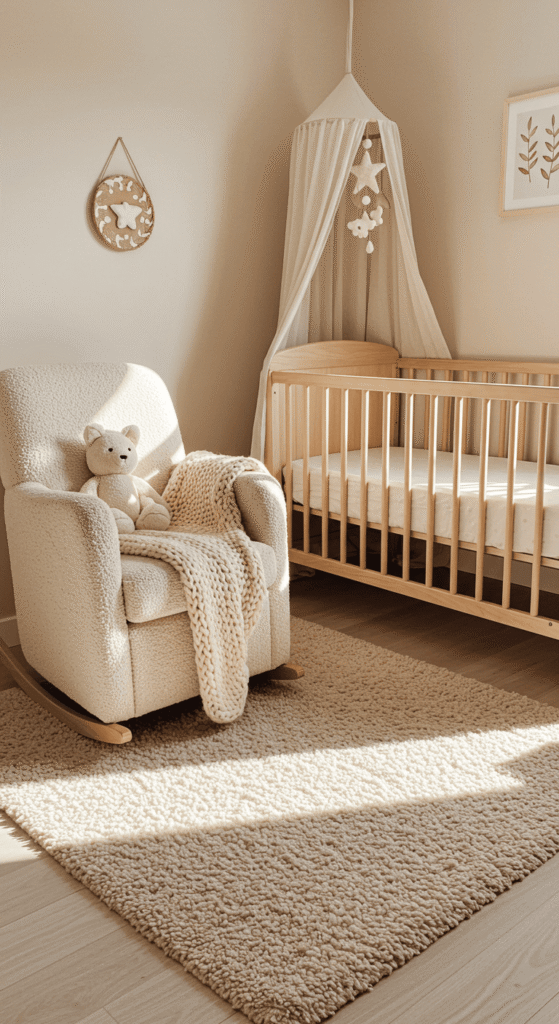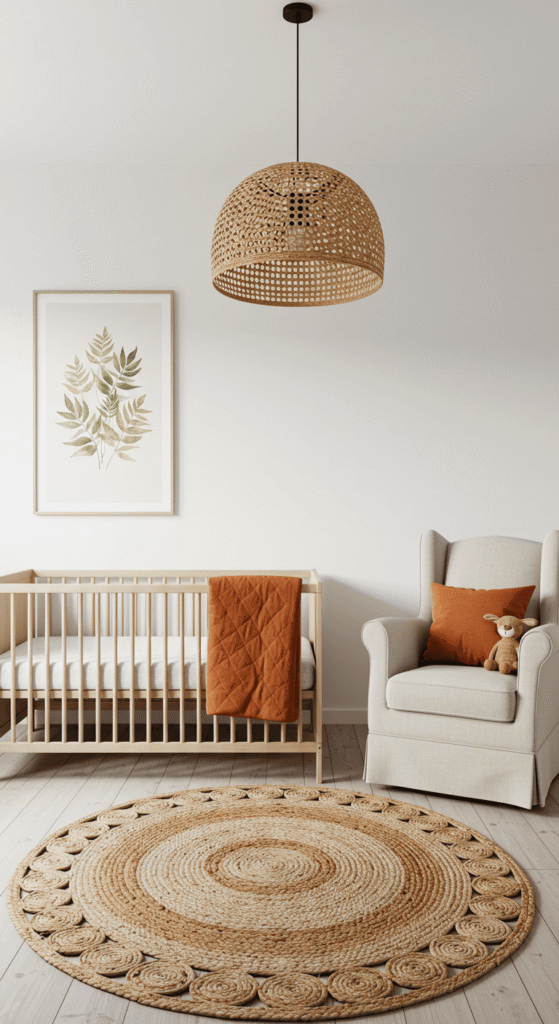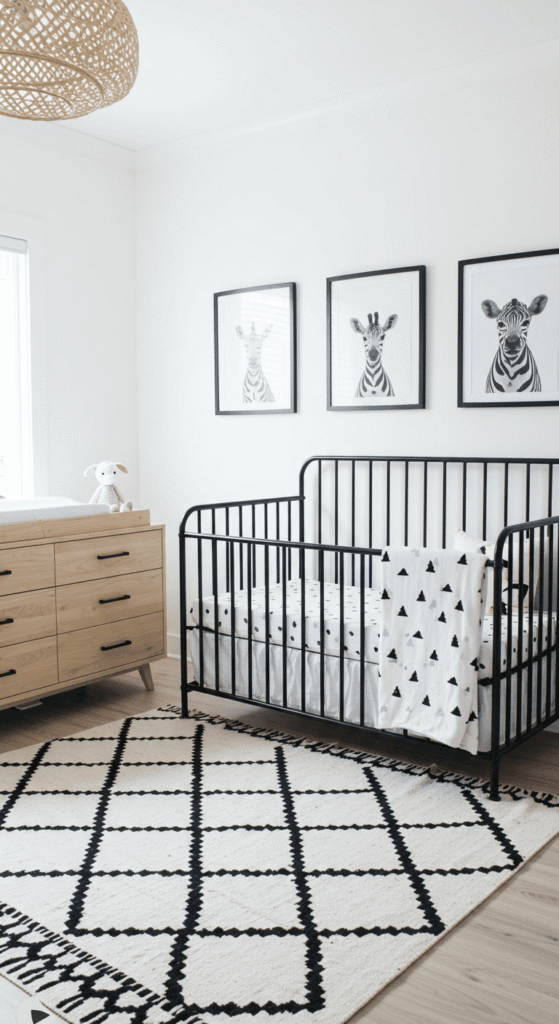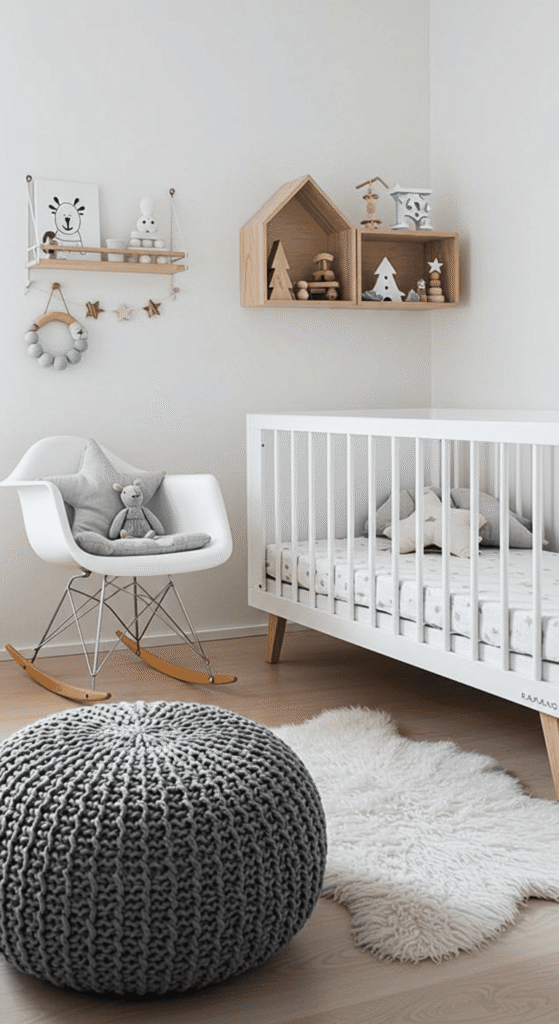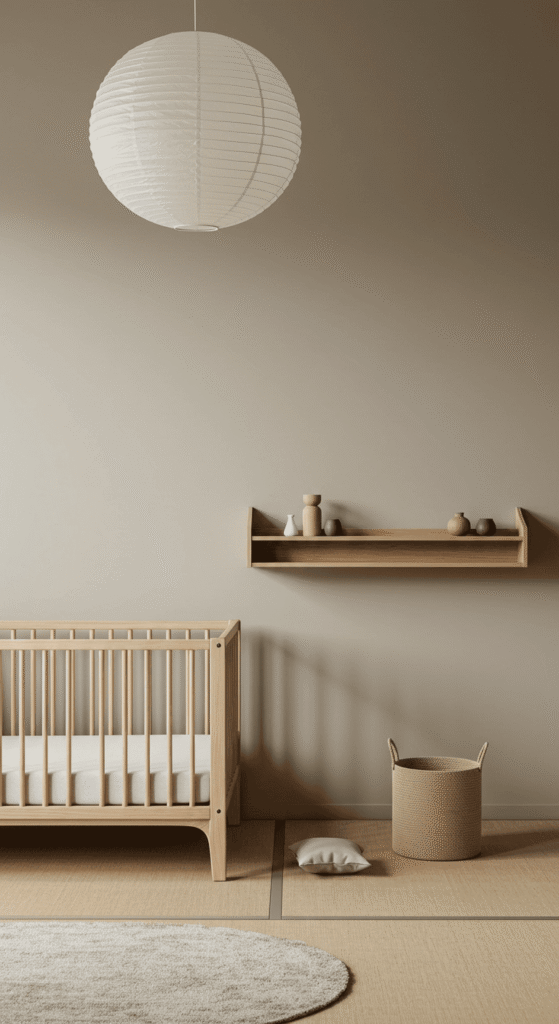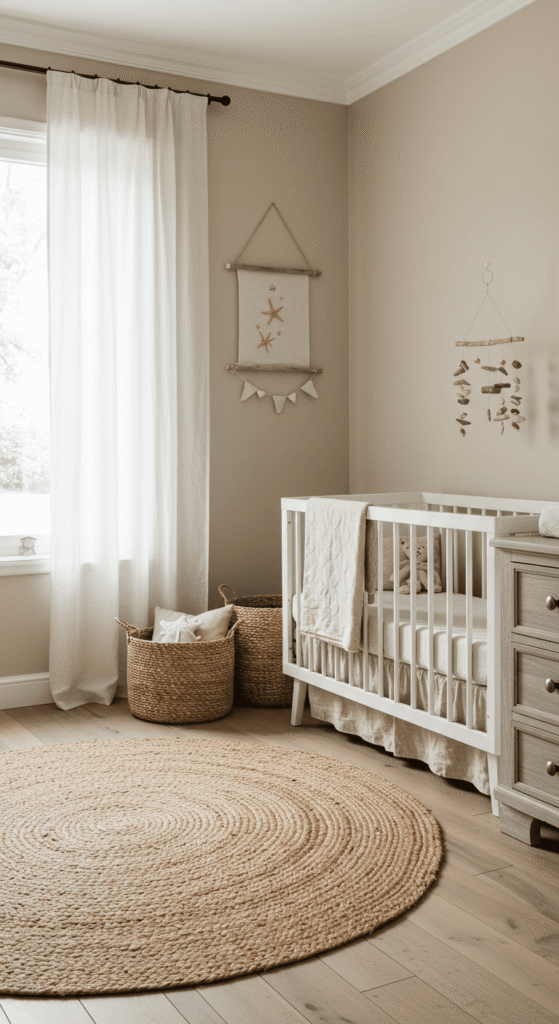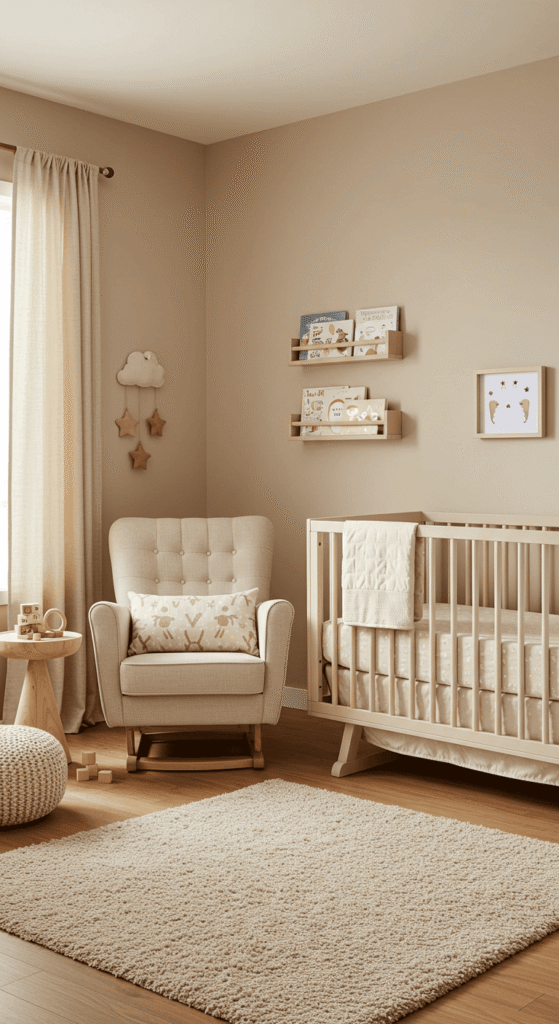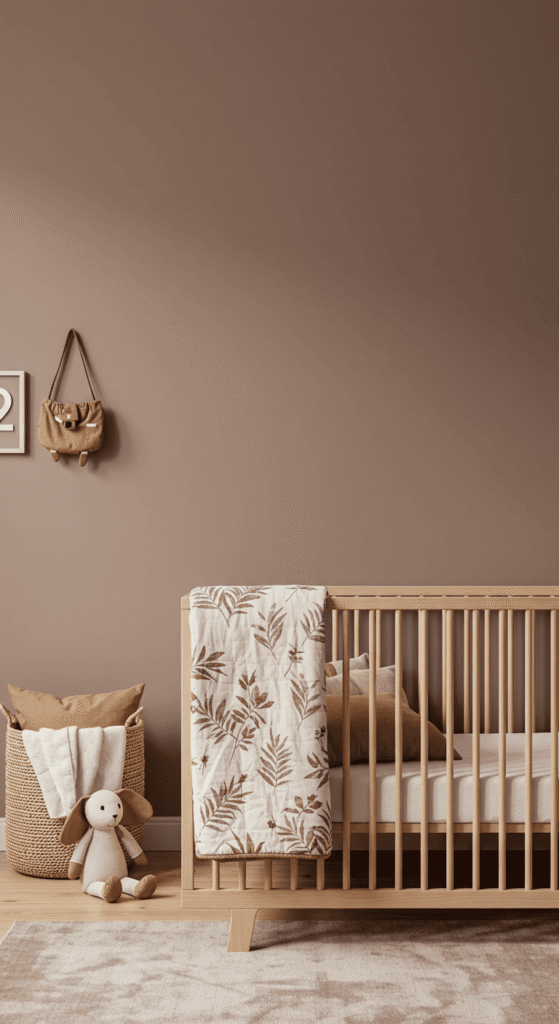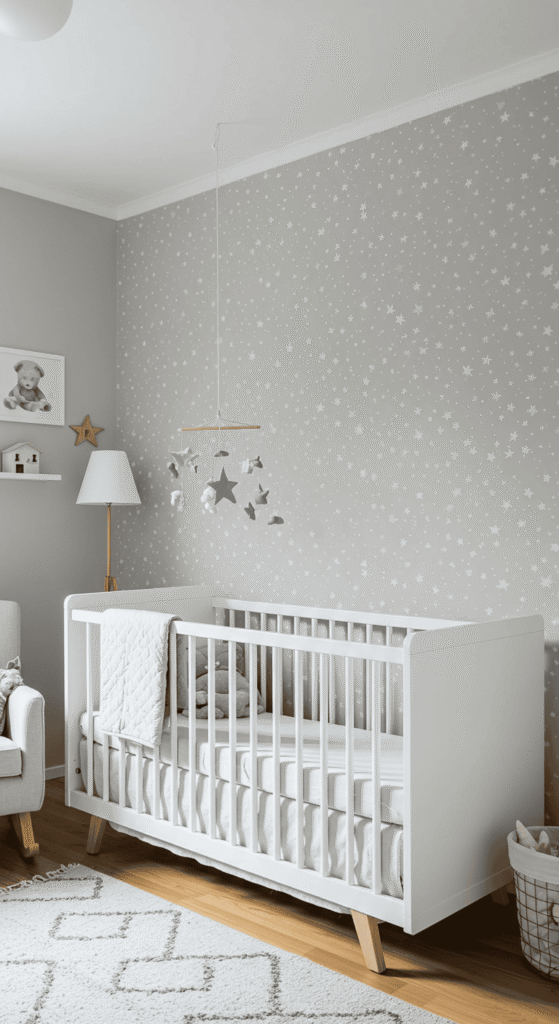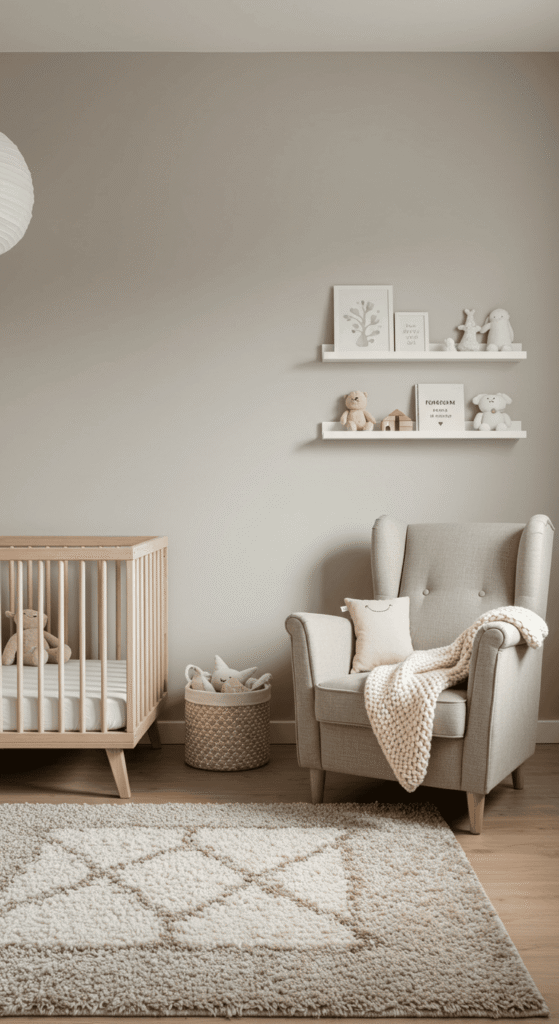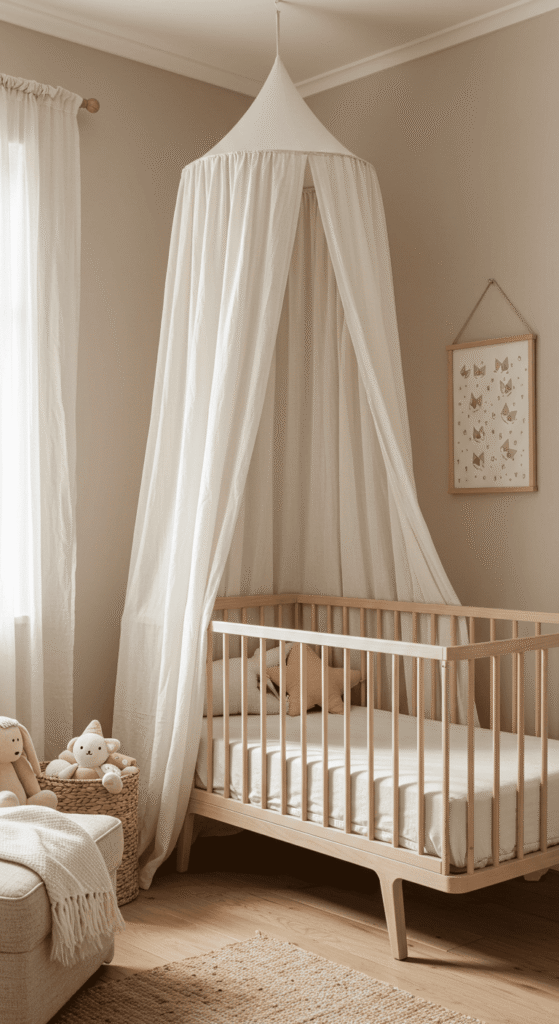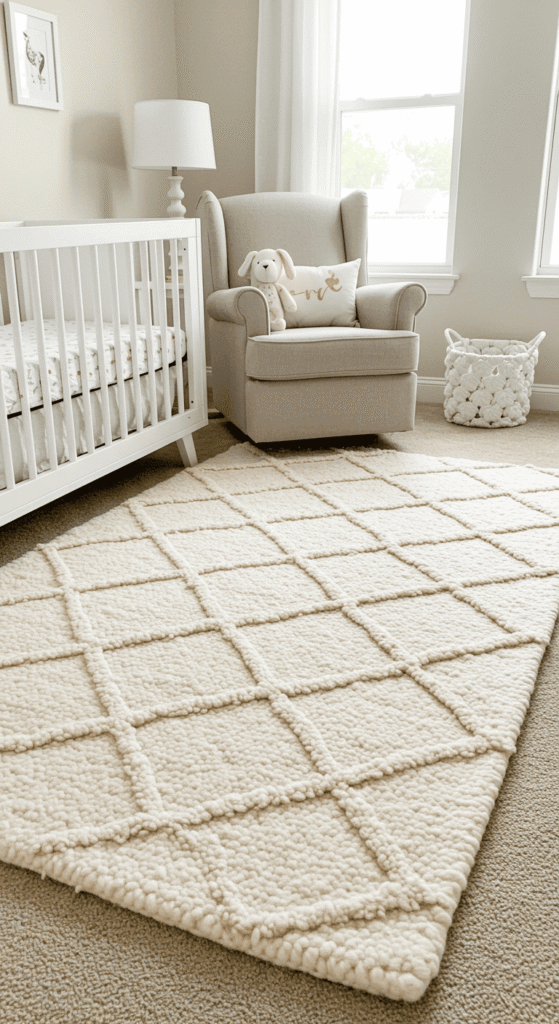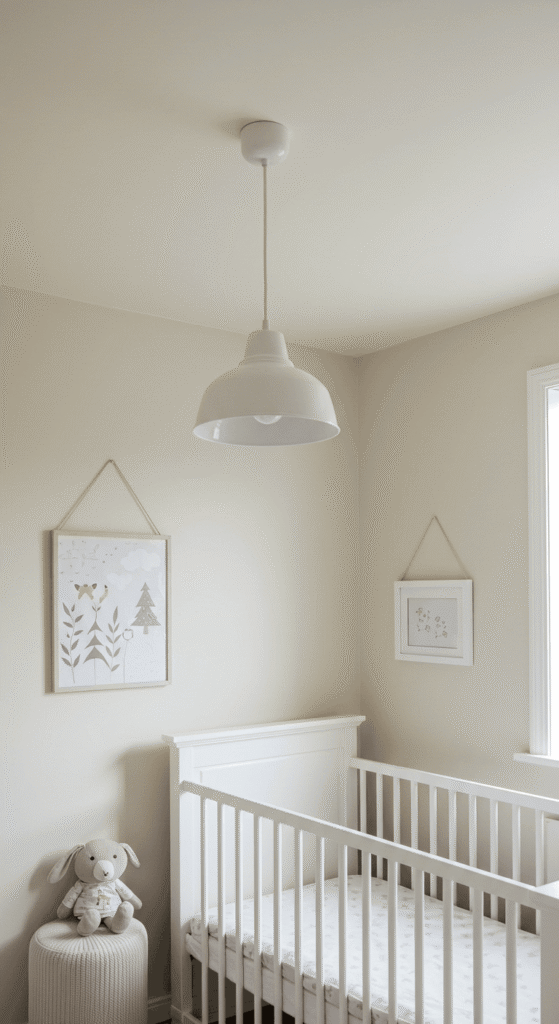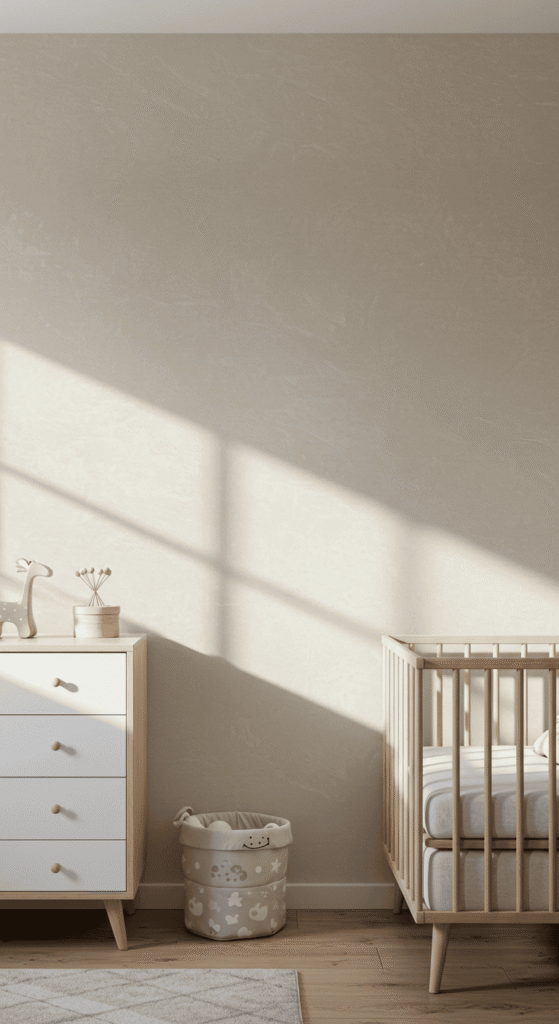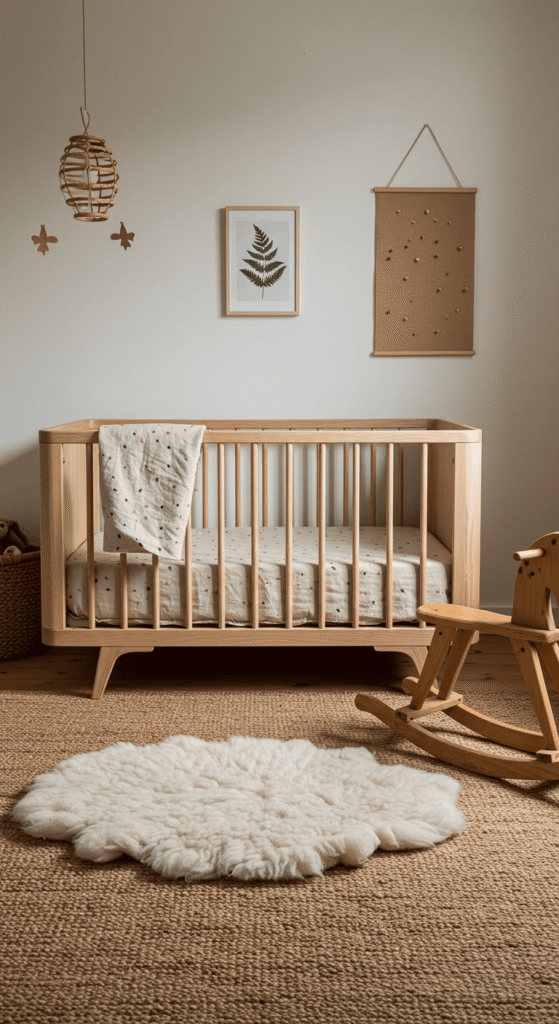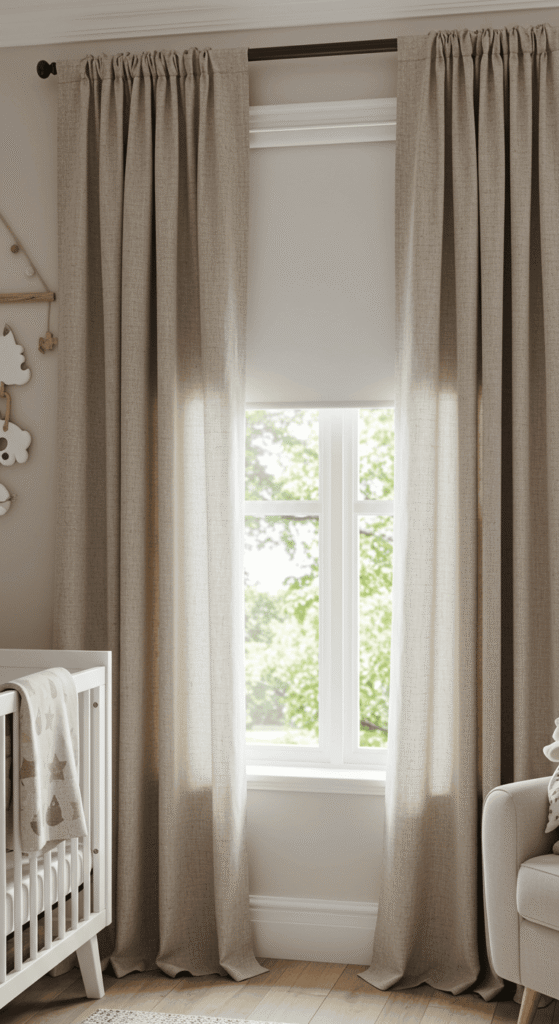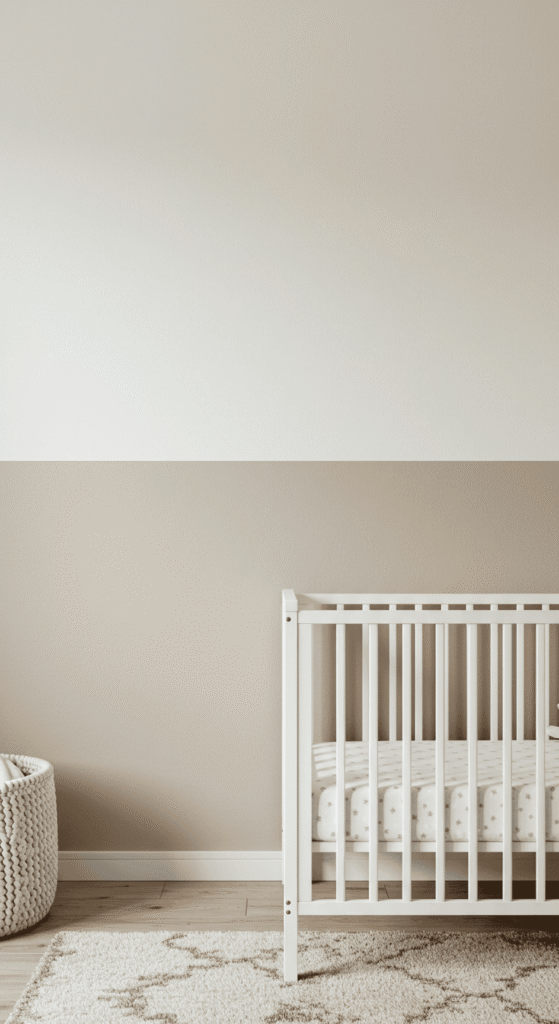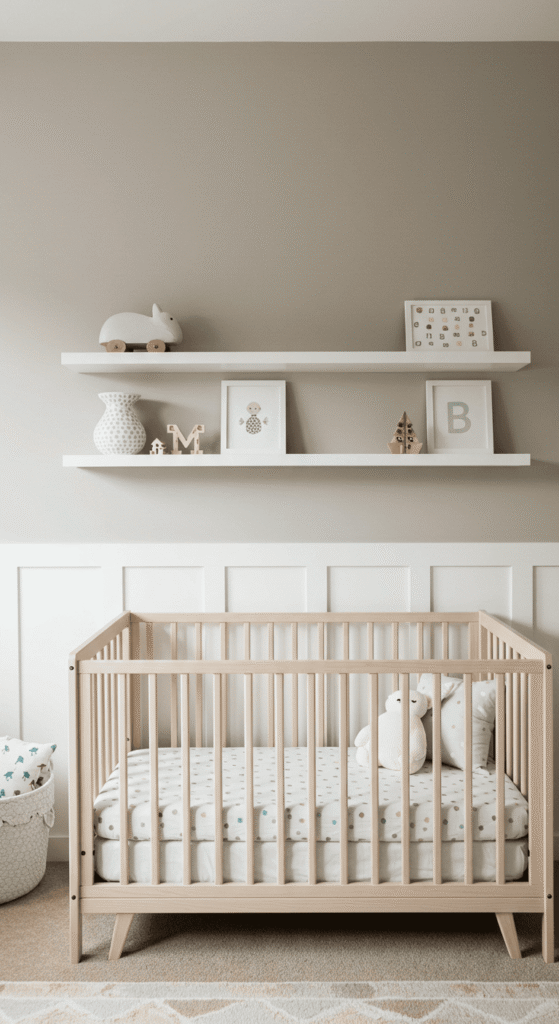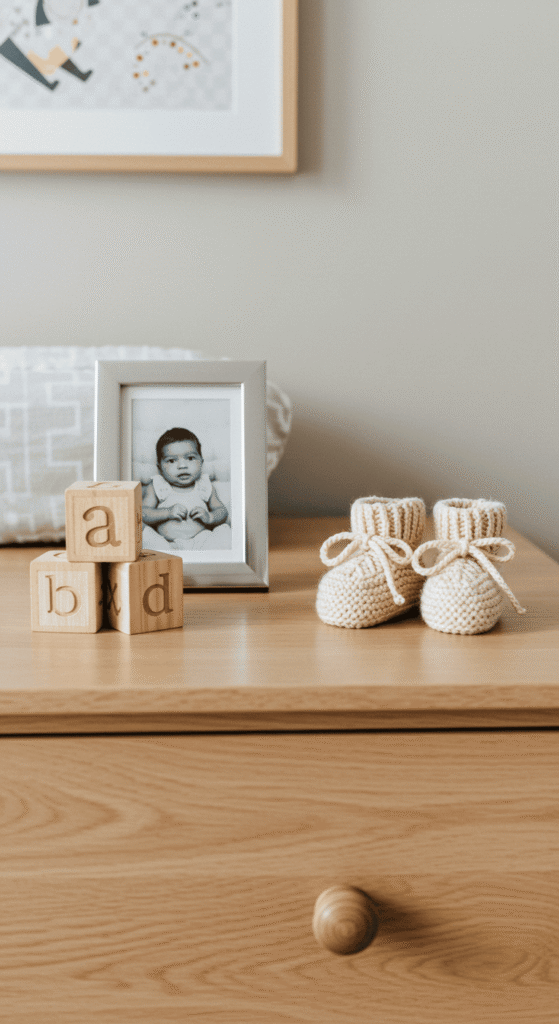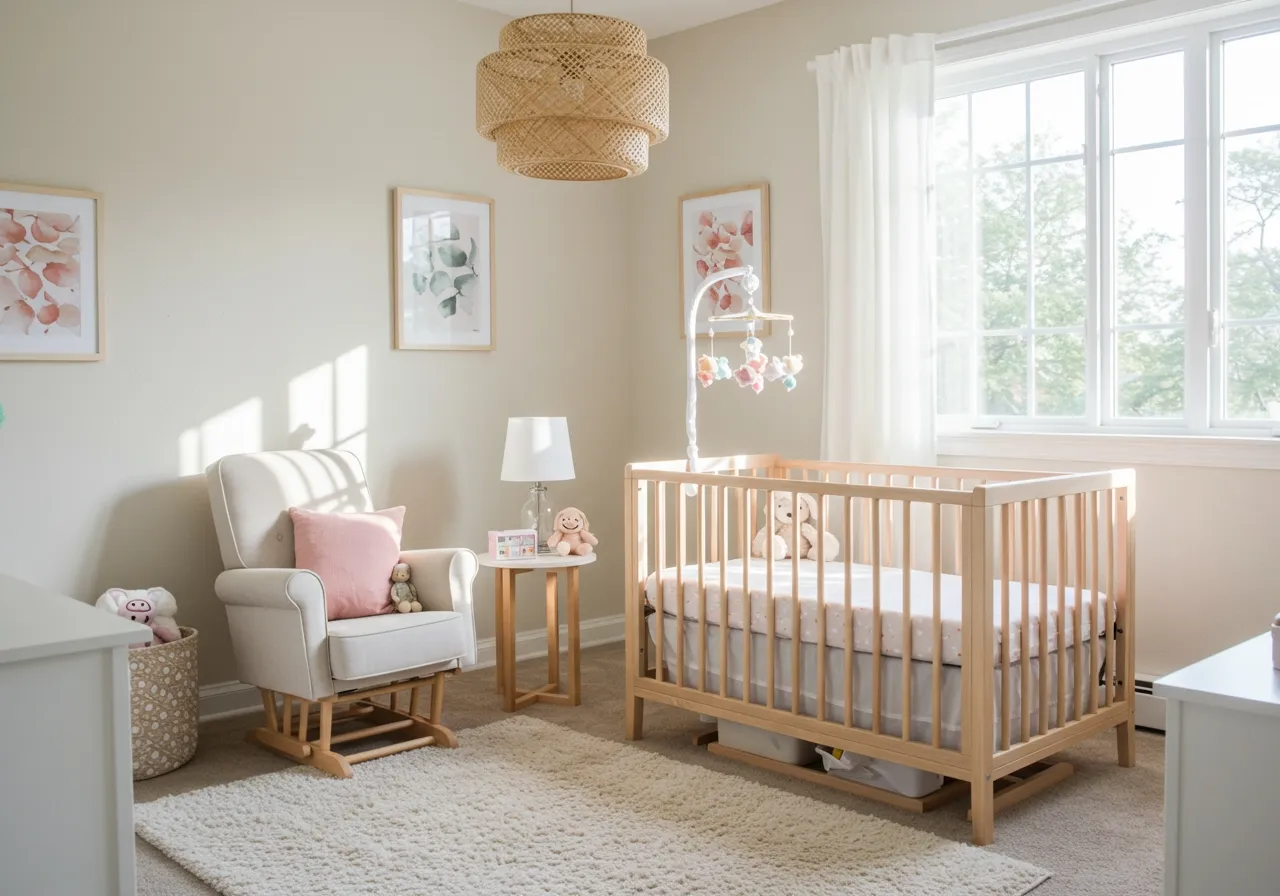Nesting time is here! Creating that perfect haven for your baby is pure joy. Lately, there’s a huge love for neutral nursery ideas, moving beyond traditional pinks and blues. Why? Neutral palettes (think soft creams, warm woods, gentle greys) are incredibly calming and serene. They’re also wonderfully versatile, growing with your child, and effortlessly chic and gender-neutral.
Ready to design a tranquil, timeless space? We’ve gathered some truly inspiring neutral nursery concepts packed with tips and trending touches. Let’s dive into creating a dreamy haven for your little one! For more setup tips, explore our guide to nursery room decor.
1. Warm Woods Meet Creamy Clouds
There’s something inherently cozy and timeless about pairing natural wood tones with soft, creamy whites. This combination feels grounded yet airy, creating a nurturing environment.
- Why it Works: The warmth of wood (think light oak, maple, or ash) prevents an all-white or cream space from feeling stark. Creamy whites, rather than pure brilliant white, add a layer of softness and sophistication.
- Get the Look: Opt for a wooden crib as the centerpiece. Layer different textures in cream: a plush high-pile rug, linen curtains, a boucle nursing chair, and soft knit blankets. Keep walls a soft off-white or warm cream.
- Expert Tip: Don’t be afraid to mix wood tones slightly, but keep them in the same warm family for cohesion.
2. Sophisticated Greys with Tactile Touches
Grey doesn’t have to mean gloomy! When done right, a grey-based neutral nursery is incredibly chic and soothing. The secret is in the shades you choose and the textures you incorporate.
- Why it Works: Grey is a fantastic neutral base that allows other elements to shine. It pairs well with virtually any accent color you might want to add later. Using various textures prevents it from feeling flat.
- Get the Look: Choose warm greys (greige) or soft dove greys rather than cool, industrial tones. Introduce textures like chunky knit poufs, faux fur rugs (or sheepskin), woven storage baskets, and perhaps a feature wall with subtle grey-patterned wallpaper (like delicate stripes or stars). Mix white and wood furniture for contrast.
- Expert Tip: Layer multiple shades of grey – a slightly darker shade for the glider, a lighter one for the walls, and mid-tones in textiles – to create depth and visual interest.
3. Grounded in Nature: Earthy Tones Take Root
Bring the calming influence of the outdoors in with a nursery inspired by earthy tones. Think terracotta, muted olive green, sandy beige, and soft ochre.
- Why it Works: These colours are inherently grounding and peaceful. They connect the space to the natural world, creating a serene and organic feel that’s perfect for a little one’s room.
- Get the Look: Use a base of warm white or beige on the walls. Introduce earthy tones through textiles – a terracotta-colored cushion, an olive green changing pad cover, a sandy-toned rug. Incorporate natural materials like rattan (for a light fixture or mirror frame), jute (baskets or rugs), and light wood furniture. Add a touch of greenery with a baby-safe plant (like a spider plant) on a high shelf.
- Expert Tip: Use these earthy shades as accents rather than painting the whole room terracotta. This keeps the space feeling light and airy while still benefiting from the warmth of these colours.
4. High Contrast Harmony: Black, White & Wood
Who says neutral has to mean no drama? A carefully curated mix of black, white, and warm wood creates a nursery that is strikingly modern, graphic, and surprisingly warm.
- Why it Works: The high contrast between black and white creates visual interest and definition, while natural wood elements prevent the scheme from feeling cold. It’s a sophisticated palette that easily transitions into a toddler’s room.
- Get the Look: Start with a base of white walls. Introduce black through smaller, deliberate accents: a minimalist black metal crib, thin black picture frames, a patterned black and white rug, or drawer handles on a wooden dresser. Warm wood furniture (like a changing table or bookshelf) is crucial for adding warmth and balance.
- Expert Tip: Use black sparingly to avoid overwhelming the space. Think accents, not large swathes of color. Ensure plenty of natural light or good artificial lighting to keep the room feeling bright.
5. Scandinavian Simplicity: Light, Bright & Functional
Inspired by Nordic design principles, a Scandinavian neutral nursery emphasizes minimalism, functionality, natural light, and a connection to nature through light woods and simple forms.
- Why it Works: This style is inherently calming and clutter-free. Its focus on natural materials and light creates an airy, peaceful atmosphere perfect for a nursery. It’s timeless and effortlessly chic.
- Get the Look: Keep walls white or a very pale grey. Furniture should be functional with clean lines, often in light woods like birch or pine, or simple white finishes. Incorporate cozy textiles like sheepskin rugs (faux or real), wool blankets, and simple cotton bedding. Add subtle pops of muted color (like dusty rose or soft blue) or graphic black and white patterns through toys or prints.
- Expert Tip: Declutter ruthlessly! Scandinavian design relies on open space and curated items. Use clever storage solutions like simple wooden crates or canvas bins to keep essentials tidy and accessible.
6. Japandi Serenity: Where Minimalism Meets Nature
Combine the best of Japanese minimalism and Scandinavian warmth for an ultra-serene Japandi-style neutral nursery. This aesthetic prioritizes clean lines, natural materials, and functional simplicity.
- Why it Works: Japandi design is inherently calming, focusing on decluttered spaces, craftsmanship, and a deep connection to nature through materials. It creates a truly tranquil and mindful environment.
- Get the Look: Use light wood tones (like ash or light oak) paired with darker contrasts (like walnut or even black accents). Keep furniture low-profile with clean lines. Incorporate natural textures like bamboo, paper lanterns (safely placed), stone-like ceramics, and linen. Stick to a palette of warm whites, creams, muted greys, and natural wood.
- Expert Tip: Emphasize negative space – don’t feel the need to fill every corner. Allow key pieces room to breathe, enhancing the minimalist and peaceful feel.
7. Subtle Coastal Calm: Breezy Neutrals
Evoke the tranquility of the seaside without resorting to overt nautical themes. A subtle coastal neutral nursery uses soft, sandy beiges, weathered wood tones, and hints of misty grey or pale blue-grey to create a light, airy, and relaxing atmosphere.
- Why it Works: Coastal style is inherently calming. By focusing on the neutral elements – sand, driftwood, clouds – you get that breezy feel without literal anchors or seashells, making it sophisticated and timeless.
- Get the Look: Use a base of sandy beige or soft off-white walls. Incorporate weathered or whitewashed wood furniture. Add textures reminiscent of the coast: woven seagrass baskets, linen fabrics, a chunky jute rug, and perhaps subtle striped patterns in muted tones on cushions or throws. Consider accessories like a driftwood mobile (ensure safety) or simple seascapes in neutral frames.
- Expert Tip: Introduce a hint of the palest, most muted blue-grey as an accent – perhaps on a single cushion or a small piece of art – to subtly nod to the sea and sky without breaking the neutral scheme.
8. Monochrome Magic: Layering Shades of Beige
Dive deep into one neutral family, like beige, and explore its incredible range. Layering various shades, tints, and tones of beige creates a subtly complex, incredibly warm, and cohesive nursery environment.
- Why it Works: Sticking to variations of a single neutral hue forces you to play with texture and tone, resulting in a rich, sophisticated look that feels intentional and deeply calming. Beige offers a huge spectrum from cool stone to warm sand.
- Get the Look: Choose a primary beige shade for the walls (e.g., a mid-tone greige). Then, layer lighter and darker beige elements: a dark beige velvet rocking chair, creamy beige curtains, a light beige patterned rug, taupe storage bins, and warm beige knit blankets. Incorporate different materials like linen, cotton, wool, and wood to add depth.
- Expert Tip: To prevent a monochrome beige room from feeling flat, ensure you have a wide range of textures and at least 3-4 distinct shades of beige present in significant amounts. A touch of crisp white in the trim or ceiling can help define the space.
9. Earthy Mushroom Tones: A Sophisticated Neutral Palette
Move beyond basic beige and explore the nuanced world of mushroom hues. This sophisticated palette ranges from cool, greyish taupes to warmer, pinkish-browns, offering a unique and grounding neutral base.
- Why it Works: Mushroom tones are earthy and complex, providing more depth than standard beige while remaining calming and neutral. They feel contemporary and pair beautifully with natural wood and creamy whites.
- Get the Look: Use a warm mushroom shade on the walls or as a key furniture color (like the nursing chair). Layer with lighter creams, deeper taupes, and perhaps hints of muted terracotta or olive for complexity. Natural wood furniture complements these tones perfectly.
- Expert Tip: Test these shades carefully, as they can change dramatically in different lighting. Look for mushroom tones with undertones that harmonize with your flooring and other fixed elements.
10. Whispers of Pattern: Subtle Wallpaper Wonders
Introduce visual interest without overwhelming the space by using subtly patterned wallpaper on an accent wall (or even all four, if the pattern is delicate enough!). This adds depth and personality while maintaining the neutral calm.
- Why it Works: A subtle pattern breaks up solid blocks of neutral color, adding a layer of sophistication and gentle stimulation. It can define a zone, like the area behind the crib, making it feel extra special.
- Get the Look: Choose wallpapers with delicate motifs in neutral tones – think tiny stars, faint stripes, subtle geometric shapes, soft watercolour washes, or tone-on-tone damask. Apply it to one feature wall, often the one behind the crib or changing table. Keep the rest of the room’s elements relatively simple to let the wallpaper shine.
- Expert Tip: Opt for peel-and-stick wallpaper if you’re renting or prefer a less permanent option. It’s easier to apply and remove, allowing you to update the look as your child grows.
11. Ultra-Minimalist Calm: Less is Truly More
For the ultimate serene space, embrace strict minimalism. This approach focuses on essentialism, eliminating clutter and leaving only functional, beautiful items in a calm neutral setting.
- Why it Works: Minimalism reduces visual noise, creating an incredibly peaceful and focused environment, ideal for rest and calm interaction. Every item has a purpose and is chosen with intention.
- Get the Look: Start with plain neutral walls (white, very light grey). Choose furniture with the simplest forms and clean lines, often in white or light wood. Storage must be concealed – think built-in closets or minimalist cabinets. Only display a very select few, meaningful toys or books. Keep textiles simple and unpatterned, focusing on quality materials.
- Expert Tip: Minimalism requires discipline! Focus on multi-functional pieces (like a dresser that’s also the changing station) and have a rigorous system for tidying away anything not immediately in use.
12. The Perfect Blend: Embracing Greige
Can’t decide between grey and beige? You don’t have to! Greige, that magical blend of grey and beige, offers the best of both worlds – the sophistication of grey and the warmth of beige. It’s the ultimate versatile neutral.
- Why it Works: Greige provides a perfectly balanced neutral backdrop that adapts beautifully to different lighting conditions and pairs effortlessly with almost any accent color or material, from crisp white to warm woods to black accents.
- Get the Look: Use greige as your primary wall color. Layer different shades of greige, grey, beige, and cream throughout the room in textiles, rugs, and furniture. It pairs exceptionally well with natural wood tones and white furniture. Add texture through knits, boucle, and linen to enhance the cozy feel.
- Expert Tip: Pay attention to the undertones of your chosen greige. Some lean slightly cooler (more grey), while others lean warmer (more beige). Choose one that complements the natural light in your room and the other finishes you plan to use. Test paint samples on different walls!
13. Canopy Dreams: Soft Draping for Whimsy
Add a touch of ethereal charm and whimsy to your neutral nursery by incorporating a soft canopy. Whether draped over the crib (ensure it’s safely installed and positioned) or creating a cozy reading nook, a canopy instantly softens the space.
- Why it Works: Canopies create a sense of enclosure and intimacy, making the crib or a corner feel like a special haven. The soft fabric adds vertical interest and a lovely textural element, enhancing the dreamy quality of the room.
- Get the Look: Choose a canopy in a light, neutral fabric like sheer cotton, gauze, or linen in shades of white, cream, or pale beige. Ensure it’s securely fastened to the ceiling or wall and positioned so it cannot fall into the crib or become an entanglement hazard. Alternatively, create a reading corner with floor cushions under a canopy hung from the ceiling.
- Expert Tip: Keep the canopy simple. Avoid heavy fabrics or overly elaborate designs which can overwhelm a neutral space and potentially gather more dust. Safety is paramount – always follow installation instructions carefully and check regularly.
14. Focus on the Floor: Statement Neutral Rugs
Don’t underestimate the impact of the floor! A beautiful, textured neutral rug can anchor the entire nursery design, add significant warmth and comfort, and provide a soft play surface.
- Why it Works: In a neutral room, a rug is a fantastic opportunity to introduce texture, subtle pattern, or tonal variation without adding strong color. It defines the space, absorbs sound (helpful for naps!), and feels wonderful underfoot during those middle-of-the-night wake-ups.
- Get the Look: Opt for rugs made from natural materials like wool, cotton, or jute in neutral shades. Consider textures like high piles, chunky loops, braided designs, or subtle geometric or organic patterns in tone-on-tone neutrals. Ensure the rug is large enough to sit partially under the main furniture pieces (crib, chair) to ground the arrangement.
- Expert Tip: Choose a rug material that’s durable and relatively easy to clean – spills are inevitable! Wool is naturally stain-resistant, and flatweaves or low-pile rugs are often easier to vacuum than super-shaggy ones. A good rug pad underneath will prevent slipping and add extra cushioning.
15. Look Up! Subtle Ceiling Interest
Don’t forget the fifth wall! Adding a subtle detail to the ceiling can draw the eye upward, making the room feel more complete and considered, even within a neutral scheme.
- Why it Works: Ceiling treatments add an unexpected layer of design interest. A soft color or subtle texture can make the room feel cozier or more expansive, depending on the approach.
- Get the Look: Paint the ceiling a very pale, complementary neutral shade – perhaps a whisper of blush-beige against cream walls, or a soft sky grey. Consider adding simple, thin beadboard paneling painted white or cream. A beautifully chosen, neutral light fixture also draws attention upward.
- Expert Tip: Avoid anything too dark or visually heavy on the ceiling, as this can make the room feel lower. Keep it light and airy to maintain the serene neutral atmosphere.
16. Limewash Walls: Cloudy Depth & Texture
For a truly unique and organic wall finish, consider limewash paint in a soft neutral hue. It creates a beautiful, subtly textured effect reminiscent of ancient plaster walls.
- Why it Works: Limewash provides a soft, matte, slightly mottled finish with natural variations in color depth, adding far more character than standard flat paint. It enhances the feeling of calm and natural connection.
- Get the Look: Apply limewash paint (available in various neutral shades) using specific brush techniques (often criss-cross strokes) to achieve the characteristic cloudy texture. It works beautifully in creams, soft beiges, pale greys, or earthy tones.
- Expert Tip: Limewash requires a specific application process and works best on porous surfaces like plaster or drywall. Research the technique or hire a professional if unsure. The finish is breathable and eco-friendly.
17. Truly Eco-Conscious Choices: Sustainable Neutrals
Design a beautiful neutral nursery with a focus on sustainability and non-toxic materials. Choose organic fabrics, reclaimed wood, and eco-friendly finishes for a healthier space for baby and planet.
- Why it Works: Creating a non-toxic environment is paramount for a baby. Choosing sustainable options aligns with conscious living values and often results in beautiful, natural aesthetics.
- Get the Look: Opt for GOTS-certified organic cotton bedding and clothing. Look for cribs and dressers made from solid, sustainably harvested wood with non-toxic, low-VOC finishes. Choose rugs made from natural, untreated fibers like wool or jute. Consider cork flooring or wall accents. Buy secondhand furniture and refinish safely.
- Expert Tip: Research brands and certifications. Look for labels like Greenguard Gold for furniture and low-VOC or zero-VOC for paints to ensure low chemical emissions.
18. Layered Window Treatments: Function Meets Style
Dress the windows for both beauty and practicality by layering different types of window treatments in coordinating neutral shades.
- Why it Works: Layering allows for optimal light control and privacy – sheer curtains filter light beautifully during the day, while blackout blinds or shades are essential for naps. Using coordinating neutrals keeps the look cohesive and adds textural depth.
- Get the Look: Install functional blackout roller shades or cellular blinds fitted inside the window frame. Layer over them with soft, flowing curtains in a complementary neutral fabric like linen or cotton, hung on a simple rod extending beyond the frame.
- Expert Tip: Choose curtain fabrics and blind colors that work together tonally (e.g., cream sheers over beige blackout blinds, or white blinds with soft grey curtains). Ensure blackout layers provide sufficient darkness for daytime sleep.
19. Two-Tone Walls: Chic & Structured Neutrality
Add architectural interest and a custom feel without pattern by embracing two-tone walls. Painting the walls in two different neutral shades, often divided horizontally, creates subtle definition and depth.
- Why it Works: This technique visually breaks up large wall expanses, making the room feel more structured and designed. It’s a sophisticated way to add interest while staying firmly within the neutral palette.
- Get the Look: A popular approach is painting the lower third or half of the wall in a slightly darker or warmer neutral (like a soft greige or taupe) and the upper portion in a lighter shade (like warm white or cream). Use high-quality painter’s tape for a crisp, clean line. You could also consider vertical color blocking behind the crib for a modern twist.
- Expert Tip: Generally, placing the darker shade on the bottom helps ground the space. Ensure the two neutral tones you choose share similar undertones (both warm-leaning or both cool-leaning) for the most harmonious effect.
20. Beadboard Charm: Classic Texture
Add timeless character and subtle texture with beadboard wainscoting on the lower portion of the walls, painted in a soft neutral color.
- Why it Works: Beadboard adds architectural detail and a classic, slightly coastal or cottage feel without being overly theme-y. It protects the lower walls and provides a lovely textural backdrop for furniture.
- Get the Look: Install beadboard panels on the bottom third or half of the walls, topped with a simple chair rail molding. Paint the beadboard and trim in a durable satin or semi-gloss finish – perhaps classic white, cream, or a soft greige, contrasting slightly with the upper wall color.
- Expert Tip: Beadboard is relatively easy to install and adds significant visual impact. It’s particularly effective in creating a cozy, grounded feel in the nursery.
21. The Personal Touch: Weaving in Meaning
Finally, make your neutral nursery uniquely yours by incorporating meaningful personal touches and perhaps even family heirlooms. A neutral backdrop is perfect for letting these special items truly shine.
- Why it Works: These elements infuse the room with love, history, and personality, transforming it from a beautifully decorated space into a deeply personal haven for your baby. They tell your family’s story.
- Get the Look: Frame a cherished family photo (consider black and white or sepia for a timeless, neutral feel). Display a special, well-preserved heirloom toy on a high shelf (ensure safety). Incorporate a handmade gift, like a knitted blanket or a simple mobile, made with love by a relative or friend. Once baby arrives, add their tiny footprints or handprints in a neutral frame.
- Expert Tip: Curate carefully – choose just a few significant pieces to display rather than creating clutter. Ensure any older items or heirlooms are clean, safe, and placed securely out of baby’s reach if they aren’t designed for infant use. Let these items be focal points that spark joy.
Creating a neutral nursery is all about building layers of calm, comfort, and subtle style. We hope these ideas have sparked your imagination and help you design the perfect peaceful retreat for your little one. Happy decorating!


